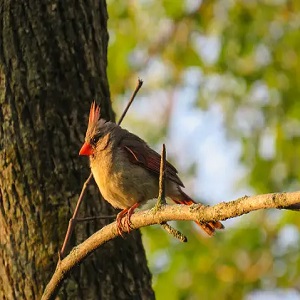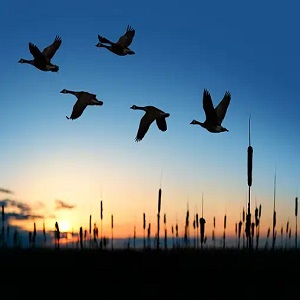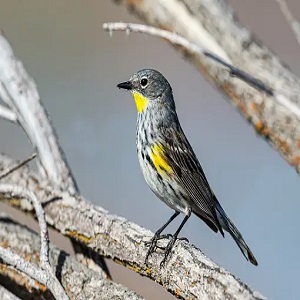Introduction: Birds Of Michigan!
Birds of Michigan diverse landscapes, from dense forests to sparkling lakeshores, provide an ideal habitat for a rich variety of bird species. Whether you’re an avid birdwatcher or simply enjoy the soothing sounds of feathered friends in your backyard, Michigan offers a treasure trove of avian wonders to discover. In this guide, we’ll introduce you to the top 33 backyard birds that call the Great Lakes State home.

From the iconic American Robin with its cheerful song to the striking Northern Cardinal with its vibrant plumage, Michigan’s birdlife offers something for every bird enthusiast. You’ll learn about the majestic Bald Eagle, symbolizing strength and freedom, and the charming Ruby-throated Hummingbird, a tiny marvel that flits about in search of nectar. We’ll also delve into the intriguing behaviors, nesting habits, and migratory patterns of these feathered residents.
Whether you’re observing them in your backyard, local parks, or along Michigan’s scenic birding trails, these 33 bird species will inspire a deeper connection to the natural world around you. So grab your binoculars and join us on a journey to discover the fascinating birds of Michigan.
Top Backyard Birds in Michigan: Identification Charts and Photos
Michigan boasts a diverse range of backyard birds, making it a birdwatcher’s paradise. Some common species include the American Robin, with its distinctive orange breast, and the Northern Cardinal, known for its vibrant red plumage. You’ll also spot the Eastern Bluebird, recognized by its bright blue feathers.
The Black-capped Chickadee’s distinct black cap and the Mourning Dove’s soft cooing are easily identifiable. Keep an eye out for the American Goldfinch, known for its yellow hue, and the House Sparrow, with its brown and gray coloring. These colorful feathered friends make Michigan’s backyard birdwatching a delightful and rewarding experience.
Discover the most common backyard birds found throughout Michigan

Michigan is home to a diverse range of backyard birds, with some of the most common species being the Northern Cardinal, American Robin, House Sparrow, Black-capped Chickadee, and Mourning Dove.
These colorful birds are frequent visitors to feeders and gardens. Blue Jays, American Goldfinches, and Eastern Bluebirds are also prevalent, adding vibrant hues to the landscape. Common Grackles and Red-winged Blackbirds are often seen near water sources.
In winter, Dark-eyed Juncos and American Tree Sparrows forage for food. Michigan’s woods attract the White-breasted Nuthatch, while the American Crow is ubiquitous. Overall, Michigan’s backyard birdwatching offers a delightful array of feathered friends for enthusiasts.
Use our identification charts and photos to easily recognize these feathered visitors
Certainly! Identifying feathered visitors is a joy with the help of identification charts and photos. Look for distinctive features like coloration, size, and beak shape. Vibrant red plumage often indicates a Northern Cardinal, while a yellow body with black wings may point to an American Goldfinch.
Robins are known for their orange breasts, and the striking blue of a Blue Jay is hard to miss. Keep your charts handy for quick reference and enjoy birdwatching!
Learn about their unique characteristics and behaviors that make them stand out
Birds of Michigan exhibit unique characteristics and behaviors that set them apart. One standout feature is their adaptation to diverse habitats, from forests to wetlands. The iconic Common Loon is renowned for its haunting calls and striking black-and-white plumage, often seen on freshwater lakes.
The Piping Plover, a rare and endangered species, nests along sandy shorelines and relies on camouflage to protect its nests. Michigan’s state bird, the American Robin, is known for its cheerful springtime song and red breast. The Sandhill Crane, with its tall stature and distinctive rattling calls, is a common sight in wetlands.
The Kirtland’s Warbler, a rare warbler species, is unique to Michigan’s jack pine forests and is celebrated for its melodious song and conservation efforts. These avian marvels make Michigan a captivating birdwatching destination.
Enhance your birdwatching experience by attracting these beautiful creatures to your own backyard

Attracting birds to your backyard in Michigan can be a rewarding and enjoyable way to enhance your birdwatching experience. Michigan is home to a diverse range of bird species, and with a few simple steps, you can create an inviting habitat for these beautiful creatures.
- Provide Bird Feeders: Bird feeders are a great way to attract a variety of birds to your backyard. Different species prefer different types of food, so consider having multiple feeders with various types of seeds, such as black oil sunflower seeds, safflower seeds, nyjer seeds, and suet. Make sure to keep the feeders clean and filled regularly.
- Install Bird Baths: Birds need access to fresh water for drinking and bathing. Installing a bird bath or two in your yard can be a real draw for birds.
- Plant Native Plants: Native plants provide natural food sources and shelter for birds. Consider planting native trees, shrubs, and flowers that produce berries, seeds, or nectar. Some good options for Michigan include serviceberry, Eastern red cedar, and native wildflowers like coneflowers and milkweed.
- Offer Nesting Sites: Providing suitable nesting sites can encourage birds to stay in your backyard. You can put up birdhouses designed for specific bird species or leave natural cavities in trees if safe to do so. Make sure to place them at the appropriate height and orientation.
- Create a Bird-Friendly Landscape: Avoid the use of pesticides and herbicides in your yard, as these chemicals can harm both birds and their insect prey. A more natural and diverse landscape will attract a wider range of bird species.
- Use Bird-Friendly Features: Reflective window glass can be hazardous to birds. Consider using window decals or screens to prevent bird collisions. You can also provide perches near windows for birds to rest and observe their surroundings.
- Practice Patience: Birdwatching often requires patience. Sit quietly and observe from a comfortable vantage point. Birds may take some time to discover your backyard habitat and become comfortable visiting it regularly.
- Keep Cats Indoors: If you have cats, it’s essential to keep them indoors or use cat enclosures to prevent them from preying on birds and other wildlife.
- Learn About Local Birds: Familiarize yourself with the bird species that are common in your area of Michigan. This will help you identify and appreciate the birds you attract to your backyard.
- Record Your Observations: Consider keeping a birdwatching journal to record the different species you see, their behaviors, and any interesting observations. This can be a fun way to track the birds that visit your backyard over time.
What Does Birds Of Prey Mean? Most Important Facts, Definition, Characteristics & Examples [2023]
Common Backyard Birds: Mockingbirds and Thrashers
Mockingbirds and thrashers are common backyard birds known for their melodious songs and distinctive behaviors. Mockingbirds, with their gray plumage and white patches on their wings, are expert mimics, replicating the calls of other birds and even mechanical sounds. They’re often seen perched on tree branches or wires, serenading the surroundings with their diverse repertoire.
Thrashers, on the other hand, are slightly larger with brownish-gray feathers and striking yellow eyes. They are known for their habit of vigorously “thrashing” through leaf litter in search of insects and small prey. Their sharp calls and ground-foraging behavior make them a unique and entertaining addition to any backyard birdwatcher’s list. Both these species bring music and charm to your outdoor spaces, making them cherished visitors to suburban and urban gardens alike.
Mimicking Mastery: Songs that Mesmerize

Michigan’s avian symphony enchants with diverse melodies. The Northern Cardinal, a vibrant red virtuoso, serenades with clear, whistling notes. Eastern Bluebirds, azure minstrels, deliver melodious trills that evoke pure delight. Warblers, tiny but tenacious, craft intricate tunes among the branches, their songs a tapestry of color and sound. The American Goldfinch, a golden troubadour, trills softly as it flits through the meadows.
The haunting call of the Common Loon on tranquil lakes echoes like a mournful ballad. Red-winged Blackbirds compose lively, staccato scores in marshy domains. And the enchanting, flute-like song of the Hermit Thrush carries through Michigan’s woodlands, leaving an indelible mark.
These feathered artists, Michigan’s melodious marvels, paint the air with their songs, a captivating masterpiece of nature’s making.
Feeding Habits: A Diverse Diet
Birds in Michigan exhibit a diverse range of feeding habits, reflecting the state’s varied ecosystems and the availability of different food sources throughout the year. Michigan’s birds can be broadly categorized into several feeding guilds, each with its own dietary preferences. Here’s an overview of the feeding habits of birds commonly found in Michigan:
1. Insectivores:
- Many birds in Michigan are insectivorous and primarily feed on insects and other invertebrates.
- Examples include warblers, flycatchers, swallows, and woodpeckers.
2. Granivores:
- Granivorous birds primarily feed on seeds, including those of grasses, wildflowers, and shrubs.
- Common examples are sparrows, finches, and juncos.
3. Frugivores:
- Frugivorous birds consume fruits and berries, especially during the fall and winter when insects are less abundant.
- Cedar waxwings and robins are notable frugivores.
4. Carnivores:
- Carnivorous birds in Michigan often prey on smaller animals, including other birds, rodents, amphibians, and fish.
- Raptors such as hawks, eagles, and owls are top carnivores.
5. Piscivores:
- Piscivorous birds specialize in catching fish. They are commonly found near lakes, rivers, and wetlands.
- Examples include herons, egrets, and kingfishers.
6. Nectarivores:
- Some birds, like hummingbirds, have specialized bills and feed on nectar from flowers.
7. Omnivores:
- Omnivorous birds have a varied diet, including insects, seeds, fruits, and small vertebrates.
- Common examples include crows, blue jays, and starlings.
8. Scavengers:
- Scavengers feed on carrion, which includes dead animals. They play a vital role in recycling nutrients in the ecosystem.
- Turkey vultures are prominent scavengers in Michigan.
9. Herbivores:
- Some birds primarily eat plant material, such as leaves, buds, and shoots.
- Waterfowl like ducks and geese are herbivores that graze on aquatic vegetation.
10. Opportunistic Feeders:
- Many birds in Michigan are opportunistic and adapt their diet based on seasonal food availability.
- Common examples are cardinals, sparrows, and blackbirds.
It’s important to note that bird species in Michigan can exhibit a degree of dietary flexibility, especially during changing seasons. Additionally, migratory birds may have different feeding habits depending on whether they are in Michigan during the breeding season or while migrating. Providing a variety of food sources in your backyard can attract a diverse range of bird species, allowing you to observe their feeding habits up close.
Nesting Behavior: Master Architects

Birds of Michigan exhibit diverse nesting behaviors and are often considered master architects. Many species build intricate nests using a variety of materials, such as twigs, leaves, grass, and mud. Common nesting sites include trees, shrubs, cliffs, and even man-made structures like buildings and birdhouses.
Some notable examples include the American robin, which creates cup-shaped nests, and the Northern oriole, known for its hanging, pouch-like nests. Raptors like eagles and hawks construct large nests in treetops, while waterfowl often build nests near water. These nesting behaviors vary widely and are adapted to each species’ specific needs and environmental conditions in Michigan.
Preferred Habitats: From Woodlands to Suburbs
Birds in Michigan occupy a wide range of habitats, from pristine woodlands to suburban areas. Forest-dwelling species, like warblers and thrushes, thrive in lush, mature woodlands. Wetlands and marshes attract waterfowl like ducks and herons, while raptors such as hawks and eagles patrol open skies.
Grasslands house sparrows and meadowlarks, while shorebirds frequent the Great Lakes’ shores. Many birds, like cardinals and blue jays, adapt well to suburban environments, taking advantage of bird feeders and urban green spaces. Michigan’s diverse landscapes offer a haven for avian biodiversity, with each habitat catering to the specific needs of its feathered residents.
Red-bellied Woodpecker: Common Visitor to Feeders
The Red-bellied Woodpecker (Melanotropes Carolinas) is a common and charismatic visitor to bird feeders throughout its range in eastern North America, including Michigan. Despite its name, the red belly of this woodpecker is often not as prominent as its other distinguishing features. Here’s a brief overview of this delightful bird:

Appearance: The Red-bellied Woodpecker is a medium-sized woodpecker with striking markings. It boasts a zebra-like pattern on its back with a black-and-white striped appearance, a red cap on its head, and a small but noticeable red patch on its belly. The red crown is more prominent in males, while females have a red nape.
Habitat: These woodpeckers are highly adaptable and can be found in a variety of habitats, including woodlands, suburban areas, parks, and forests. They prefer habitats with a mix of trees where they can find insects, fruits, and nuts.
Feeding Habits: Red-bellied Woodpeckers have a diverse diet that includes insects, spiders, fruits, nuts, and seeds. They are particularly fond of acorns and beechnuts. They are often seen at bird feeders, where they enjoy suet, sunflower seeds, and peanuts. Their versatile diet makes them regular visitors to backyard feeding stations.
Behavior: These woodpeckers are agile and acrobatic, often seen clinging to tree trunks or hanging from branches as they search for insects hiding beneath bark. They use their strong bills to drum on tree trunks to communicate with other woodpeckers and establish territory.
Vocalizations: Red-bellied Woodpeckers have a distinctive and loud call that sounds like “kwirr” or “churr.” They are vocal year-round, making their presence known in the neighborhood.
Nesting: They nest in tree cavities, often using old nest sites created by other cavity-nesting birds. They may also excavate their own nesting cavities.
Range: Red-bellied Woodpeckers are non-migratory, and their range extends from the eastern United States into southern Canada. In Michigan, they are a familiar sight year-round.
Overall, the Red-bellied Woodpecker is a welcome and colorful addition to Michigan’s birdwatching scene. Their frequent visits to bird feeders make them a favorite among backyard bird enthusiasts, providing an excellent opportunity to observe their vibrant plumage and lively behavior up close.
Baltimore Orioles: Vibrant Backyard Visitors
Baltimore Orioles (Icterus glabella) are vibrant and enchanting backyard visitors, delighting birdwatchers across Michigan. These striking songbirds, known for their vibrant orange plumage and contrasting black markings, arrive in the state during the spring and summer months. Their presence adds a splash of color to gardens and woodlands.

These medium-sized birds have a distinct preference for sweet treats, making them easily enticed by nectar-rich flowers and fruit-bearing trees. Their primary natural diet consists of nectar, insects, and fruits, but they also have a fondness for sugary offerings like oranges and grape jelly. To attract Baltimore Orioles to your backyard, set up a dedicated feeder with nectar or offer orange halves and jelly in shallow dishes.
Their exquisite song, reminiscent of flutelike melodies, fills the air as they forage for food and build their intricate hanging nests. Baltimore Orioles are known for their skill in weaving plant fibers into pendulous, basket-like nests, often suspended from the tips of tree branches.
Observing Baltimore Orioles in your backyard is not only a visual delight but also an auditory one, as their melodious calls and vibrant plumage bring a touch of elegance and beauty to the natural world right outside your window.
Yellow-rumped Warbler: A Familiar Sight in Michigan
The Yellow-rumped Warbler (Setophaga coronate) is a familiar and beloved sight in Michigan, captivating birdwatchers with its striking appearance and charming behavior. Known for its versatility, this small songbird can be spotted throughout the state in a variety of habitats, making it a true Michigan icon.

One of the most distinguishing features of the Yellow-rumped Warbler is its distinctive plumage. During the breeding season, males showcase bright yellow patches on their throats, flanks, and rumps, which give the bird its name. They also have subtle streaks on their blue-gray backs and white undersides. In contrast, females and non-breeding individuals display a more muted coloration.
Michigan residents eagerly anticipate the arrival of these warblers during the spring migration. They undertake long journeys from their wintering grounds in the southern United States and Central America to nest in Michigan’s coniferous and mixed forests. The Yellow-rumped Warbler is well-equipped for colder climates, and its ability to digest wax-coated berries, such as juniper and bayberry, allows it to survive when insects are scarce.
Observing Warblers is a delight for bird enthusiasts, as they are agile foragers, often flitting through trees and shrubs in search of insects, spiders, and berries. Their distinctive “cheek” patches and distinctive calls make them easy to identify.
As fall arrives, these warblers, along with many other migratory birds, bid farewell to Michigan, embarking on their southward journey. However, many of them return in the spring, providing Michiganders with the joy of their vibrant presence once again. The Yellow-rumped Warbler’s adaptability, resilience, and vibrant plumage make it a cherished symbol of Michigan’s diverse avian community.
Gray Catbird: Charming Michigan Bird Species

The Gray Catbird (Dumetella carolinensis) is a charming bird species commonly found in Michigan. Recognized by its sleek gray plumage and distinctive mewing call, this songbird is a skilled mimic, imitating the sounds of other birds and even mechanical noises. It has a diverse diet, including insects, fruits, and berries, making it a valuable contributor to Michigan’s ecosystems. With its melodious songs and charismatic presence, the Gray Catbird is a favorite among bird enthusiasts in the state.
Vocalizations that Resemble a Cat’s Meow
The Gray Catbird (Dumetella carolinensis) is renowned for its unique vocalizations, which often mimic a cat’s meow, earning it its distinctive name. Its calls range from a soft, subtle mew to a more pronounced and melodious “meow.” These cat-like sounds are used for various purposes, such as territorial defense and communication with other catbirds.
Besides mimicking feline noises, they incorporate an array of other calls, whistles, and chattering sounds into their repertoire, making their vocalizations complex and intriguing. These distinct vocalizations add to the charm and fascination of the Gray Catbird, making it a delightful and engaging species for birdwatchers in Michigan and beyond.
Sleek Gray Plumage and Black Cap
The Gray Catbird (Dumetella carolinensis) boasts sleek gray plumage and a distinctive black cap on its head. Its overall appearance is characterized by elegant, soft gray feathers, which blend seamlessly with its slender body. The black cap atop its head extends to its eyes, providing a sharp contrast against its gray feathers.
This striking combination of sleek gray plumage and the prominent black cap makes the Gray Catbird a visually appealing and easily recognizable bird species in Michigan and throughout its range.
Nesting Habits in Dense Shrubs or Thickets
Gray Catbirds (Dumetella carolinensis) are known for their nesting habits, typically choosing dense shrubs or thickets as their preferred nesting locations. They construct cup-shaped nests using twigs, grasses, and other plant materials, often weaving them skillfully into the protective cover of these dense vegetation areas.
Their nesting sites are well-hidden, providing security for their eggs and chicks against potential predators. This choice of nesting habitat aligns with their shy and secretive nature, allowing them to raise their young with relative safety in the shelter of dense vegetation.
Why Do Parakeets Puff Up? 10 Most Impressive Things!
Interaction with Other Bird Species and Territory Defense
Gray Catbirds (Dumetella carolinensis) are known for their interactions with other bird species, both in territorial defense and mimicry. They are protective of their territories and will engage in aggressive behavior, including chasing away intruders, to defend their nesting sites. Their meowing calls, which resemble a cat’s meow, serve as a vocal deterrent to potential competitors.
Interestingly, catbirds are skilled mimics and can mimic the calls of other birds, including distress calls, to confuse predators and protect their nests. This mimicry can be so convincing that it can temporarily deter predators like jays and crows, which might otherwise pose a threat to their nests. This behavior highlights their adaptability and clever defense mechanisms.
Black-capped Chickadee: Small Charismatic Birds
The Black-capped Chickadee (Poecile atricapillus) is a small, charismatic bird species that graces the woodlands and backyards of Michigan and many other parts of North America. These delightful birds are known for their distinctive appearance, behavior, and vocalizations.

Black-capped Chickadees are easily recognizable by their black caps and throats, white cheeks, and grayish-blue wings and back. Their small size and striking plumage make them a favorite among birdwatchers.
One of their most endearing qualities is their friendly and fearless nature. Chickadees are known for their curiosity, and they often approach humans closely, especially when they sense the possibility of food. They readily visit bird feeders, where they enjoy seeds, particularly sunflower seeds, and suet. Their willingness to interact with people has endeared them to many backyard bird enthusiasts.
These birds are also renowned for their distinct “chick-a-dee-dee-dee” call, which varies in intensity depending on the level of threat from potential predators. They use this vocalization to communicate within their flock and to alert others about the presence of predators.
In addition to their charismatic qualities, Black-capped Chickadees are admired for their adaptability to harsh winters. They cache food throughout their territory, relying on their excellent spatial memory to locate these hidden food stores during lean times.
Overall, the Black-capped Chickadee’s small size, distinctive appearance, friendly demeanor, and lively vocalizations make it a beloved and charming bird species in Michigan and beyond, bringing joy to birdwatchers and nature enthusiasts throughout the year.
FAQ’s:
What are some common bird species found in Michigan?
Michigan is home to a diverse range of bird species, including the American Robin, Northern Cardinal, Mourning Dove, Blue Jay, and Mallard Duck, among many others.
When is the best time for birdwatching in Michigan?
Spring and fall are excellent times for birdwatching in Michigan due to the migratory birds passing through the state. However, birdwatching can be enjoyable year-round, with winter offering opportunities to spot wintering species.
What are some unique birding destinations in Michigan?
Michigan offers fantastic birding locations, including Sleeping Bear Dunes National Lakeshore, Pointe Mouillee State Game Area, and Magee Marsh Wildlife Area, where you can observe a wide variety of bird species.
Are there any rare or endangered bird species in Michigan?
Yes, Michigan is home to some rare and endangered bird species, including the Piping Plover, Kirtland’s Warbler, and Eastern Mississauga rattlesnake, which rely on specific habitats and conservation efforts for their survival.
How can I attract more birds to my backyard in Michigan?
To attract birds to your backyard, provide bird feeders with a variety of seeds, suet, and fresh water. Plant native trees and shrubs to offer shelter and natural food sources. Also, consider adding bird baths and nest boxes to create a bird-friendly environment.


